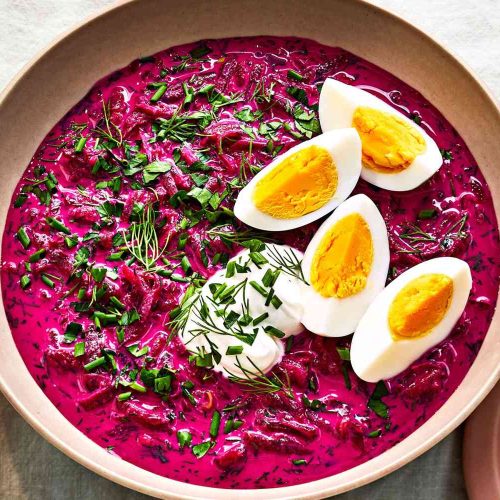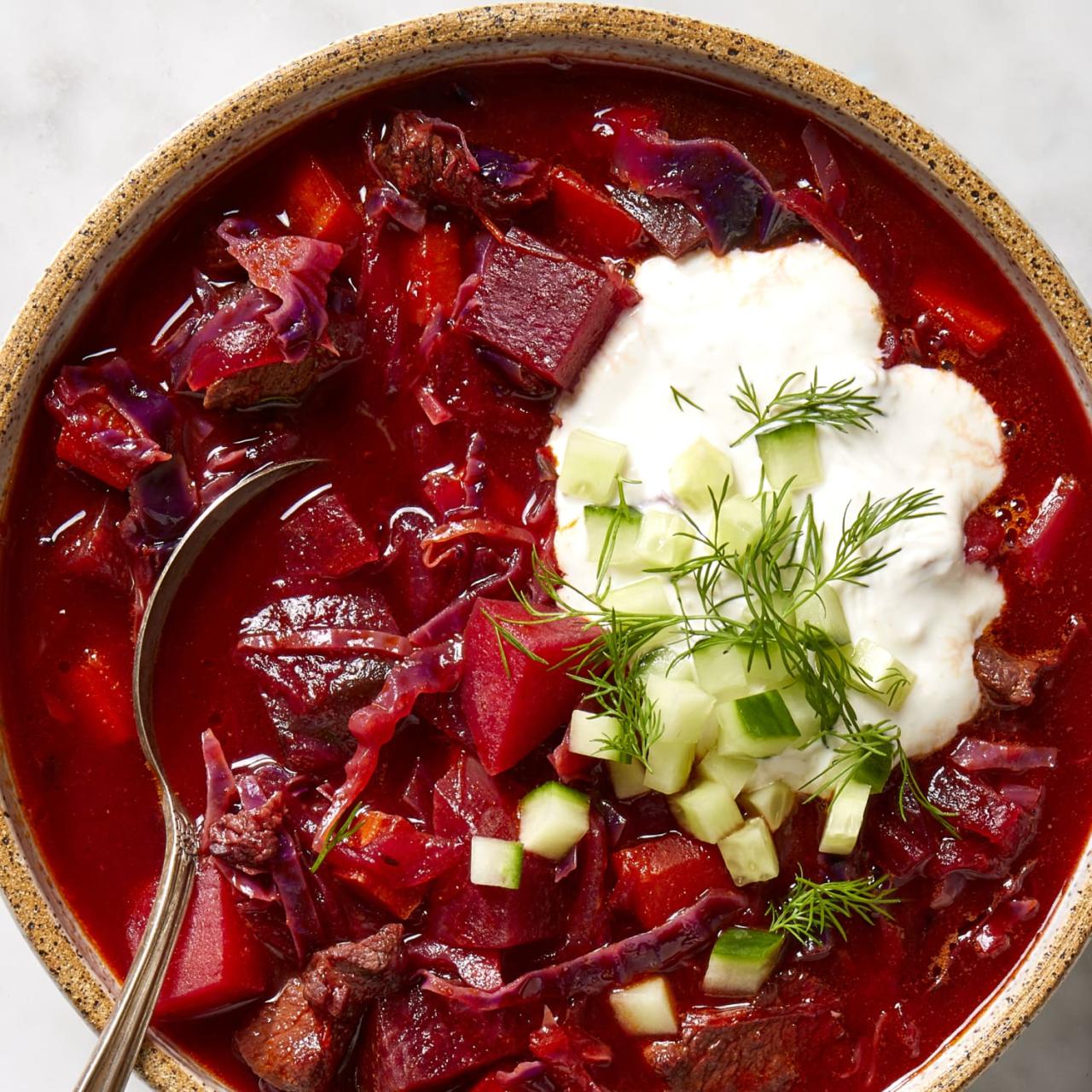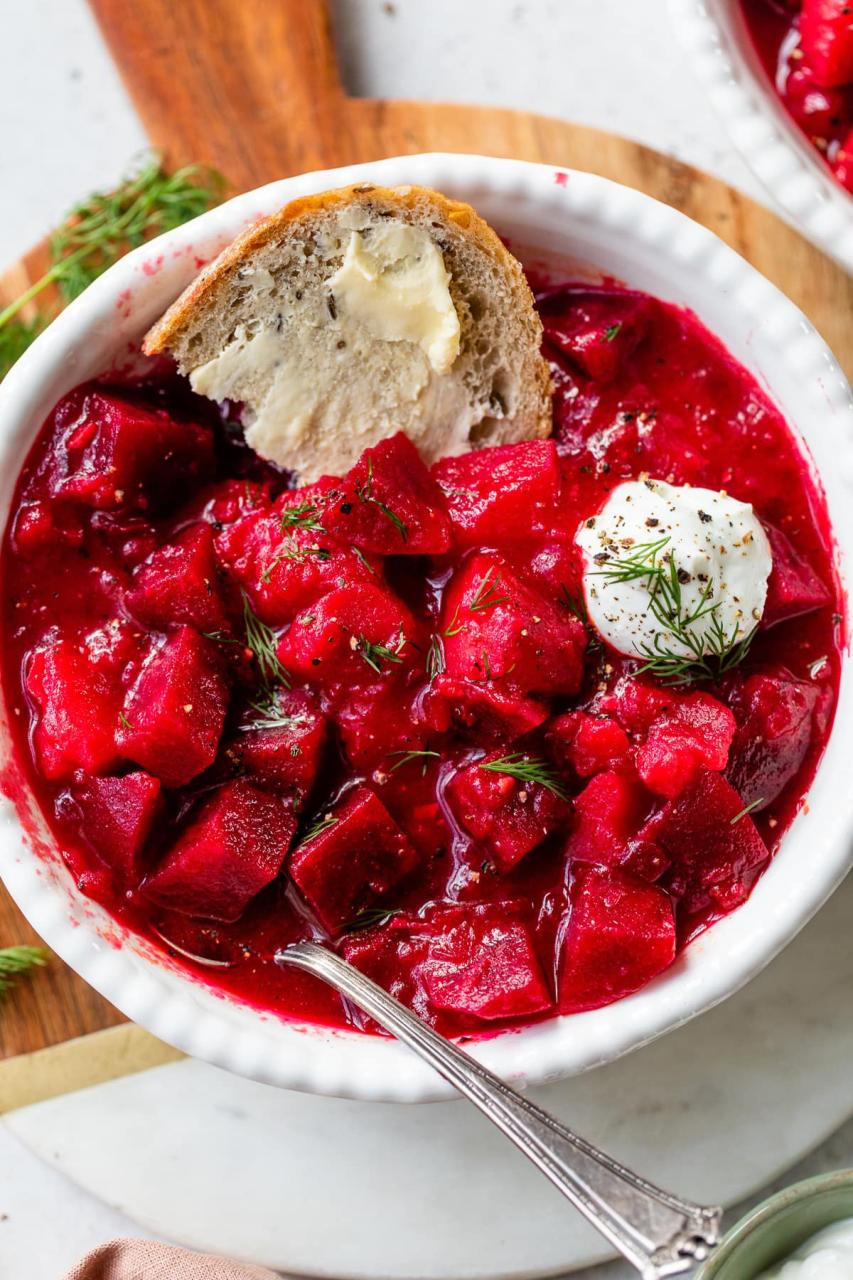During a winter adventure through the heart of Russia, where the snow blankets everything in sight and the cold air whispers tales of tradition, I discovered the soul-warming dish known as Borscht. This traditional Russian cuisine, a beautifully vibrant soup made with beets, tomatoes, and carrots, captivates with its deep crimson color and hearty, comforting flavors. The sweet earthiness of the beets, the acidity of the tomatoes, and the subtle sweetness of the carrots create a symphony of taste that seems to embody the warmth and hospitality of Russian culture.
Motivated by this culinary revelation, I embarked on a journey to recreate this comforting dish back home. Through trial and error, I managed to capture the essence of authentic Borscht, achieving the perfect balance between hearty vegetables and a rich, flavorful broth. Now, I am eager to share this recipe with you, bringing a taste of Russian warmth to your table. This Borscht is not merely a recipe; it’s an invitation to explore the vast landscapes and traditions of Russia, one spoonful at a time.

Borscht Russian cuisine
Equipment
- 1 pan
Ingredients
- 1 medium beet
- 1 large carrot
- 1 very large onion
- 1 red bell pepper
- 200 g of chopped cabbage young
- 3 potatoes
- 3 large tomatoes
- 2 large cloves of garlic
- salt pepper
- leaf parsley and lovage
Instructions
- All vegetables are laying on the line, doing zazharku and minutes apart – as cutting and shredding. Please send to the boiling broth of finely chopped onion, grated on a coarse grater beets, then carrots.
- Should be sent to cut small cubes potatoes, and after the bell pepper strips. Then add salt, pepper and grated tomatoes.
- The last ship in the soup finely shredded cabbage, and when the soup starts to boil again – greens. Turn off the heat and give borscht stand, uncovered. While cooking soup does not need to be covered, it can change the color.
Cooking tips about Borscht Russian cuisine

- Quality of Beets: The cornerstone of Borscht is, without question, the beets. Opt for firm, medium-sized beets with deep crimson hues. These will provide the soup with its characteristic color and sweet, earthy flavor.
- Vegetable Prep: Beyond beets, the inclusion of tomatoes and carrots is essential. Fresh tomatoes are preferable for their acidity and freshness, but in their off-season, canned tomatoes can work as a substitute. Carrots add sweetness and depth, so choose fresh ones and grate them finely for proper integration into the soup.
- Meat Choices (Optional): While there are vegetarian versions, traditional Borscht often includes beef or pork. If using meat, consider opting for bone-in cuts, as the bones enrich the broth with additional flavor and nutrients during the slow-cooking process.
- Layering Flavors: Begin by sautéing the root vegetables before adding your liquids. This step helps to build a foundation of flavor. Adding garlic, onions, and a bay leaf further enhances the depth of the Borscht.
- Acidity Balance: A signature of Borscht is its tangy flavor profile. Achieve this by incorporating vinegar or lemon juice towards the end of cooking. Adjust the level of acidity according to taste, remembering that it should complement the sweetness of the beets and carrots.
- Simmering Time: Borscht benefits from a long, slow simmer. This not only allows the flavors to meld together beautifully but also tenderizes any meat used in the recipe. Consider making the soup a day ahead, as its flavors deepen and improve with time.
- Dill and Sour Cream: Fresh herbs, especially dill, are traditional garnishes that add a fresh, aromatic layer to the dish. Serving Borscht with a dollop of sour cream introduces a creamy texture and slight tanginess, balancing the soup’s robustness.
- Serving Suggestions: Borscht is traditionally served with rye bread or pampushki (Ukrainian garlic bread) on the side. Offering these accompaniments allows diners to soak up the flavorful broth, ensuring not a single drop goes to waste.
Serving suggestions about Borscht Russian cuisine

- With Sour Cream: A dollop of sour cream is perhaps the most iconic accompaniment for Borscht, adding a creamy texture and a slight tang that beautifully complements the soup’s earthy and tangy flavors.
- Fresh Herbs: Sprinkle fresh dill or parsley over the top before serving. The freshness of these herbs elevates the soup’s flavor profile and adds a splash of color to its vibrant red hue.
- Rye Bread: Serve Borscht with a slice of dense, dark rye bread or pumpernickel on the side. The hearty, slightly sour flavor of the bread pairs excellently with the richness of the soup, making for a fulfilling meal.
- Garlic Cloves: It’s traditional in some regions to serve whole, raw garlic cloves with Borscht. Diners can rub the garlic on their bread or even dip it into the soup for an extra punch of flavor.
- Hard-Boiled Eggs: Offering chopped or halved hard-boiled eggs as an additional topping can add protein and richness, creating a more hearty and satisfying dish.
- Vodka or Kvass: In true Russian style, pairing Borscht with a small glass of vodka complements the meal and follows tradition. Alternatively, for a non-alcoholic option, kvass (a fermented beverage made from rye bread) offers an authentic experience.
- As a Starter or Main Course: Borscht can be served both as a warming starter to a multi-course meal or as the main course, accompanied by the suggested sides and toppings for a fuller meal.
Top 5 FAQs about Borscht Russian cuisine

- What are the essential ingredients in Borscht? The foundation of Borscht is built on beets, which give the soup its characteristic crimson color and sweet, earthy flavor. Beyond beets, tomatoes and carrots play crucial roles, adding depth and a hint of sweetness and acidity to the dish. While these vegetables are key, variations of Borscht may also include potatoes, cabbage, onions, garlic, and dill for additional layers of flavor.
- Is there a meat version and a vegetarian version of Borscht? Yes, Borscht can be adapted to suit both meat lovers and vegetarians. Traditionally, many versions of Borscht include beef or pork, often starting with a broth made from bone-in cuts to enrich the soup with flavor and nutrients. For a vegetarian or vegan version, the meat can be omitted without compromising the soup’s heartiness thanks to the robust combination of vegetables and the rich broth base.
- How do you achieve the perfect balance of flavors in Borscht? Balancing the sweet, sour, and earthy tones in Borscht involves careful attention to the ingredients and their preparation. Sweetness is primarily derived from the beets and carrots, while the acidity can be adjusted with vinegar or lemon juice added towards the end of cooking. The earthy depth comes from the beets and the slow simmering of the broth, which melds all the flavors together. Tasting and adjusting seasonings as the soup cooks is crucial for achieving the perfect balance.
- What are the best serving suggestions for Borscht? Borscht is traditionally garnished with a dollop of sour cream and fresh herbs like dill, which enhance its flavor and creamy texture. It is often served with rye bread or pampushki (Ukrainian garlic bread) on the side to soak up the delicious broth. In terms of presentation, these accompaniments not only complement the taste but also pay homage to the cultural roots of the dish.
- Can Borscht be made ahead of time and does it keep well? Yes, Borscht is one of those soups that actually tastes better the next day. The flavors have more time to meld together, enhancing the overall taste and depth of the soup. It can be stored in the refrigerator for up to a week and reheats well, making it a perfect make-ahead meal for busy days or for entertaining. It can also be frozen for up to 3 months, allowing for a taste of Russian cuisine anytime.
In concluding our journey through the heart and soul of Russian cuisine with the classic Borscht, we’ve delved deep into its vibrant hues, rich flavors, and cultural significance. This journey wasn’t just about following a recipe; it was an exploration of tradition, a testament to the warmth and resilience of Russian hospitality, played out in the kitchens and dining tables across the land. Borscht, with its robust blend of beets, tomatoes, and carrots, offers more than just nourishment; it provides a connection to history, a sense of place, and a bridge to understanding the diverse tapestry of Russian life.

Leave a Reply